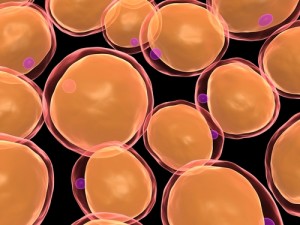 A study describing a new potential treatment for metabolic disorders based on the brown fat hormone neuregulin 4 (Nrg4) entitled “The brown fat-enriched secreted factor Nrg4 preserves metabolic homeostasis through attenuation of hepatic lipogenesis” was published in Nature Medicine by GX Wang from the University of Michigan Medical Center.
A study describing a new potential treatment for metabolic disorders based on the brown fat hormone neuregulin 4 (Nrg4) entitled “The brown fat-enriched secreted factor Nrg4 preserves metabolic homeostasis through attenuation of hepatic lipogenesis” was published in Nature Medicine by GX Wang from the University of Michigan Medical Center.
The brown adipose tissue (BAT), or brown fat, is a darker tissue due to the high mitochondria content, organelles that actively oxidize metabolic substrates for dissipating chemical energy as heat through a process called thermogenesis. In thermoregulatory thermogenesis, brown adipose tissue is essential for classical nonshivering thermogenesis that does not exist in the absence of functional brown adipose tissue as well as for the cold acclimation thermogenesis induced by the hormone norepinephrine. In brown adipose tissue, heat production is activated when the organism needs extra heat, e.g., the postnatal state, entering into a febrile state, and coming out of hibernation.
Prof. Jiandie Lin, a faculty member at the Life Sciences Institute, associate professor in the Department of Cell and Developmental Biology, and the senior author of this study, stated the existence of a paradox in this research field. On one hand the disruption of the brown fat formation makes the mice more prone to obesity, but on the other hand the removal of the protein responsible for generating heat only had modest effects on body weight. “So we figured that brown fat must be doing something besides dissipating heat,” said Prof. Lin, in the press release.
In this study, the research team asked the question: what would be the other function of brown fat tissue besides performing thermogenesis? The researchers discovered, using animal models, that a formerly unknown hormone neuregulin 4 (NRG4) secreted by the so-called brown fat cells communicates, i.e. behaving as a messenger, with the liver to regulate the conversion of glucose (sugar) into fat. They found that mice without NRG4 became obese and developed characteristic features of type 2 diabetes and fatty liver disease. And when they genetically increased the levels of NRG4 in these mice, the animals were protected from these metabolic disorders when fed a high-calorie and high-fat diet. The authors found that when NRG4 binds to its receptor on liver cells, it induces a decrease in the conversion of sugar into fat, a process believed to promote metabolic disorders like obesity and fatty liver. In the absence of NRG4, the liver is abnormally active in converting sugar into fat leading to metabolic disorders.
“In all models of obesity, NRG4 expression is reduced,” said Prof. Lin. It has been shown that in humans, the amount of NRG was negatively associated with obesity. “We think obesity is a state of NRG4 deficiency.”
It has been described in studies that the quantity of NRG4 is 3 to 5 times more prevalent in brown fat than in white fat, and humans have many more white fat cells than brown. “Probably both types of fat cells are involved,” stated Prof. Lin. “Realistically, there are still many challenges to figuring out how it acts in the body and might be used as a drug. But in general, we know that NRG4 is beneficial for body metabolism and are excited about its potential.”
Currently, the research team is investigating the potential of developing NRG4 as a new treatment for metabolic disorders, mainly for type 2 diabetes and fatty liver disease.


